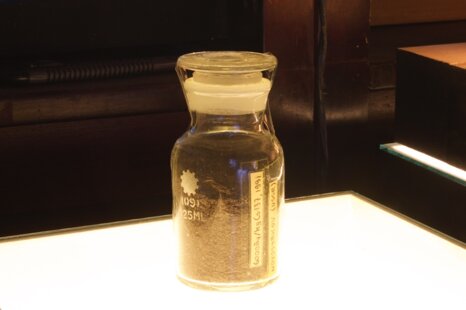postmaster@museumofanthropocenetechnology.org, via Leggiuno 32
2014 Laveno Mombello
Italia

Soil collected in a forest near Novozybkov (Russia), a 280 km drive north from Chernobyl (Ukrania) where in 1986 a nuclear reactor exploded into the open air
As a result of this explosion a cloud of radioactivity passed over large parts of Europe and the fall out of radioactive material contaminated about 200.000 km2 i.e. 2 % of its land (see Cat. Nr. 59). In 2005 the World Health Organization concluded that the accident resulted in some 50 deaths in the immediate aftermath of the explosion and a further 4000 pre-mature deaths expected to follow in the decades thereafter.
Cs-137, is an artificial radionuclide produced in a nuclear reactor from the fission of uranium. Its concentration in the collected soil was 6000 Bq/kg in 1991. By 2017 it had decayed to about 3000 Bq/kg. Less than 10% of the radioactivity in soil would transfer into food crops growing on this soil. According to the World Health Organization the limit below which contaminated food can be safely consumed is 1000 Bq/kg.). Today (52025) the concentration of Cs-137 in the sample is too low to be detected.
So far the scientific, quantifiable effects of the accident, which do however not tell the whole story.
What is more difficult to evaluate are the psychological and mental effects of the accident. These effects were found to be deeply traumatic for hundreds of thousands of people, leading to a paralyzing fatalism. Such effects are difficult to describe scientifically and required a writer such as 2015 Nobel prize winner Svetlana Alexievich. In her book “Chernobyl Prayer” (1997, Moskow, later revised several times in translations with different titles.) she carefully composes a collage of human voices that echoes all conceivable experience and that, according the Nobel Committee, deepens our comprehension of the overall human drama resulting from the Chernobyl accident.
Cat. Nr. 14
Cs-137 CONTAMINATED SOIL
1986, humans
10 x 4 cm: Cs-137 and other radionuclides, soil glass, paper